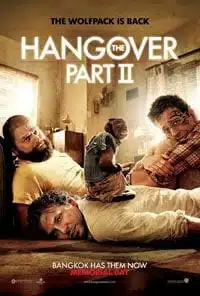
The first Hangover was not a great film, but there was a certain effortlessness to it that worked, and it was a comedy you could revisit with it retaining much of its humor, a rarity for the genre. That original success has been ‘transposed’ to exotic Thailand for this sequel, but the problem with it is that it treats us like fans – it expects us to know already who these characters are and why they’re funny. It strings us along for a ride in one of Asia’s tourist hotspots and expects us to cackle at every self-referential gag.
The Hangover Part II is not quite an exact recreation of its predecessor, but at some point in its 102-minute runtime it becomes apparent that director Todd Phillips and co. are stewing creatively. Any plot niceties are quickly dispatched; essentially, Phil, Stu and Alan (Bradley Cooper, Ed Helms and Zach Galifianakis) manage to get f*cked up again and wake up somewhere strange. The basic explanation of how this actually happens is fudged and never adequately addressed; but no matter: they have to piece together last night’s shenanigans in Bangkok’s hazy, sprawling metropolis.
This schematic device in the story is played as a pseudo-mystery, but is really just a trick to allow the story’s contrivances. There’s an underage teen missing, too: this is Teddy, the little brother of Stu’s Thai fiancée. This non-entity of a character, played by Ang Lee’s son Mason, comes as close to a MacGuffin as can possibly be. He loses a finger and his reaction is almost non-existent.
In a series in which the political incorrectness and raunchiness is more or less the point, Part II trots out a series of increasingly nasty and gratuitous scenarios. Seedy nightlife dens, drug deals and ‘ladyboys’ all crop up reliably with a sense of inevitability: in a groaningly obvious scene played for dumb laughs, a ‘ladyboy’ – the term for a Thai male that dresses and identifies as female – reveals his version of the previous night’s events. It’s hard not to expect an impending backlash against the film for peddling borderline offensive Asian stereotypes.
There is also a total lack of meaningful female characters, even more pronounced than in the first. Arguably more concerning is the way the humor affects the characters themselves – one senses Phillips has very little concern for them, by the way he inflicts cruelty after cruelty on them. It gives the film a somewhat sour taste.
Still, the film presents the same clichéd tourist view about Bangkok that the original did about Vegas; it’s part of the film’s whole conceit. And while insisting on the squalor of its setting – for The Hangover Part II both loves the glamor of Bangkok and revels in its seedy underworld reputation – it becomes apparent that Phillips has fallen in love with Thailand. He stages many beautiful aerial panoramas of the city, of sunrise over its hazy skyline, and of the country’s ravishing coastline, using those sped-up camera shots to great advantage. The production work is top-notch.
Unfortunately, the setting might be the highlight of the film. The main actors play their roles this time with a distinctly over-the-top edge that evokes ennui rather than endearment. Galifianakis, especially, has been drawn-out to seem more abnormal, and I’m not sure it works. The dialogue is more repetitive than the original, with less sharp, quotable one-liners. Paul Giamatti’s brief screen-time as a bad-tempered underworld figure is far more promising than Ken Jeong’s Mr. Chow, who is allowed to whine on rather longer than is necessary. Mike Tyson, also returning from the first, has a disappointing cameo. Finally, the way the film frantically twists the screws to produce a happy ending is risibly unconvincing.
All of this makes The Hangover Part II a serviceable but somewhat flat sequel. Phillips is never short of a dick joke to throw at the screen, however. Some of the stuff here is truly cringe-worthy and difficult to watch; you’ll want to stick around for the end credits to gauge just how much tawdriness you can tolerate. For an unabashed testosterone-fest, it fits the bill. I’m rather old-fashioned perhaps in that I think it needed rather something more to make it a good film. Or at least in league with the first.
